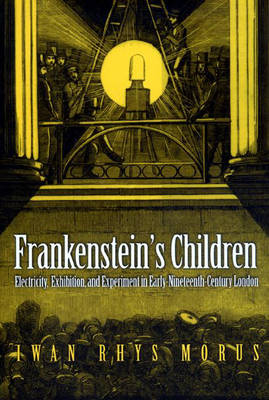
Frankenstein's Children
Electricity, Exhibition, and Experiment in Early-Nineteenth-Century London
Seiten
1998
Princeton University Press (Verlag)
978-0-691-05952-5 (ISBN)
Princeton University Press (Verlag)
978-0-691-05952-5 (ISBN)
- Titel ist leider vergriffen;
keine Neuauflage - Artikel merken
During the second quarter of the 19th century, Londoners were enthralled by a strange fluid called electricity. Revealing connections among such diverse fields as scientific lecturing, telegraphic communication, and innovative medical therapies, this book shows how electrical culture was integrated into a new machine-dominated, consumer society.
During the second quarter of the nineteenth century, Londoners were enthralled by a strange fluid called electricity. In examining this period, Iwan Morus moves beyond the conventional focus on the celebrated Michael Faraday to discuss other electrical experimenters, who aspired to spectacular public displays of their discoveries. Revealing connections among such diverse fields as scientific lecturing, laboratory research, telegraphic communication, industrial electroplating, patent conventions, and innovative medical therapies, Morus also shows how electrical culture was integrated into a new machine-dominated, consumer society. He sees the history of science as part of the history of production, and emphasizes the labor and material resources needed to make electricity work. "Frankenstein's Children" explains that Faraday, with his colleagues at the Royal Society and the Royal Institution, looked at science as the province of a highly trained elite, who presented their abstract picture of nature only to select groups. The book contrasts Faraday's views with those of other practitioners, to whom science was a practical, skill-based activity open to all.
In venues such as the Galleries of Practical Science, electrical phenomena were presented to a public less distinguished but no less enthusiastic and curious than Faraday's audiences. William Sturgeon, for instance, emphasized building apparatus and exhibiting electrical phenomena, while chemists, instrument-makers, and popular lecturers supported the London Electrical Society. These previously little studied "electricians" contributed much to the birth of "Frankenstein's children" - the not completely benign effects of electricity on a new consumer world.
During the second quarter of the nineteenth century, Londoners were enthralled by a strange fluid called electricity. In examining this period, Iwan Morus moves beyond the conventional focus on the celebrated Michael Faraday to discuss other electrical experimenters, who aspired to spectacular public displays of their discoveries. Revealing connections among such diverse fields as scientific lecturing, laboratory research, telegraphic communication, industrial electroplating, patent conventions, and innovative medical therapies, Morus also shows how electrical culture was integrated into a new machine-dominated, consumer society. He sees the history of science as part of the history of production, and emphasizes the labor and material resources needed to make electricity work. "Frankenstein's Children" explains that Faraday, with his colleagues at the Royal Society and the Royal Institution, looked at science as the province of a highly trained elite, who presented their abstract picture of nature only to select groups. The book contrasts Faraday's views with those of other practitioners, to whom science was a practical, skill-based activity open to all.
In venues such as the Galleries of Practical Science, electrical phenomena were presented to a public less distinguished but no less enthusiastic and curious than Faraday's audiences. William Sturgeon, for instance, emphasized building apparatus and exhibiting electrical phenomena, while chemists, instrument-makers, and popular lecturers supported the London Electrical Society. These previously little studied "electricians" contributed much to the birth of "Frankenstein's children" - the not completely benign effects of electricity on a new consumer world.
| List of Illustrations | ||||||||||||||||||||||||||||
| Introduction: Electricity, Experiment, and the Experimental Life | ||||||||||||||||||||||||||||
| Ch. 1 | The Errors of a Fashionable Man: Michael Faraday and the Royal Institution | |||||||||||||||||||||||||||
| Ch. 2 | The Vast Laboratory of Nature: William Sturgeon and Popular Electricity | |||||||||||||||||||||||||||
| Ch. 3 | Blending Instruction with Amusement: London's Galleries of Practical Science | |||||||||||||||||||||||||||
| Ch. 4 | A Science of Experiment and Observation: The Rise and Fall of the London Electrical Society | |||||||||||||||||||||||||||
| Ch. 5 | The Right Arm of God: Electricity and the Experimental Production of Life | |||||||||||||||||||||||||||
| Pt. 2 | Managing Machine Culture | |||||||||||||||||||||||||||
| Introduction: From Performance to Process | ||||||||||||||||||||||||||||
| Ch. 6 | They Have No Right to Look for Fame: The Patenting of Electricity | |||||||||||||||||||||||||||
| Ch. 7 | To Annihilate Time and Space: The Invention of the Telegraph | |||||||||||||||||||||||||||
| Ch. 8 | Under Medical Direction: The Regulation of Electrotherapy | |||||||||||||||||||||||||||
| Coda: The Disciplining of Experimental Life | ||||||||||||||||||||||||||||
| Notes | ||||||||||||||||||||||||||||
| Bibliography | ||||||||||||||||||||||||||||
Index
Mehr entdecken
aus dem Bereich Europa 1848/49 und der Kampf für eine neue Welt
Buch | Hardcover (2023)
DVA (Verlag)
48,00 €
Giordano Bruno - ein ketzerisches Leben
Buch | Hardcover (2024)
C.H.Beck (Verlag)
29,90 €
| ||||||||||||||||||||||||||||


